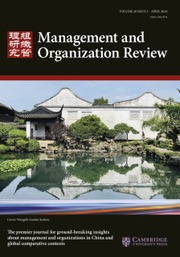No CrossRef data available.
Article contents
Hierarchical Inconsistency Among Family-Member Top Leaders and Nonfamily Executives' Compensation Levels: Evidence from Chinese Family Firms
Published online by Cambridge University Press: 12 December 2024
Abstract
In this study, we propose hierarchical inconsistency among family-member top leaders as a novel structural reason for nonfamily executives' high compensation in family firms. Hierarchical inconsistency among family-member top leaders is observed when the head in the formal business hierarchy is not ranked the highest among family-member executives and directors in the informal family hierarchy. We argue that this structure triggers contestations between the heads of the two hierarchies, adding complexity and challenges to nonfamily executives' jobs. Family firms with hierarchical inconsistency among family-member top leaders need to offer higher compensation to make up for the demanding features of these professional managers' work. The positive relationship between hierarchical inconsistency and nonfamily executives' compensation is weaker when the proportion of female family-member executives and directors is high and when the formal head's tenure is long. We use data from publicly listed family firms in China to test our arguments. Our study contributes to family business research by suggesting how the interplay between family relationships and formal organizational structures influences job features and compensation decisions.
摘要
本研究提出,家族企业中的一种结构化的因素——家族高层领导者之间的级序不一致——会导致非家族成员的高管获得更高薪酬。这种不一致主要表现在负责公司正式业务领导的层级,没有被排在负责非正式业务的其他家族成员高管之上时。作者认为,这种级序不一致的结构,会导致家族层级中最高领导者之间的相互竞争,因而增加非家族高管成员的工作复杂性和挑战性,相应的,需要提高他们的薪酬,与此同时,作者预测,当董事和高管成员中女性家族成员的比例较高时,或者负责正式业务的最高领导者任期较长时,级序不一致与非家族高管成员薪酬之间的正向关系会减弱。中国上市家族企业的数据检验并支持了上述假设。
Keywords
- Type
- Article
- Information
- Copyright
- Copyright © The Author(s), 2024. Published by Cambridge University Press on behalf of International Association for Chinese Management Research


